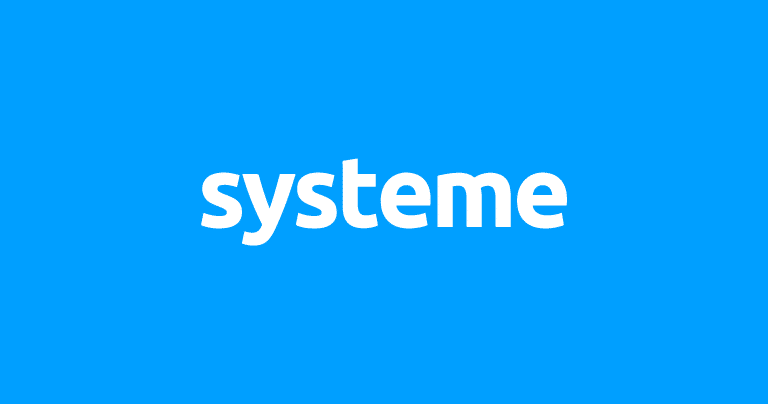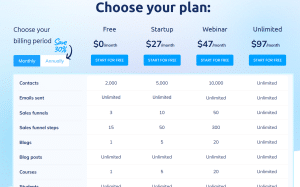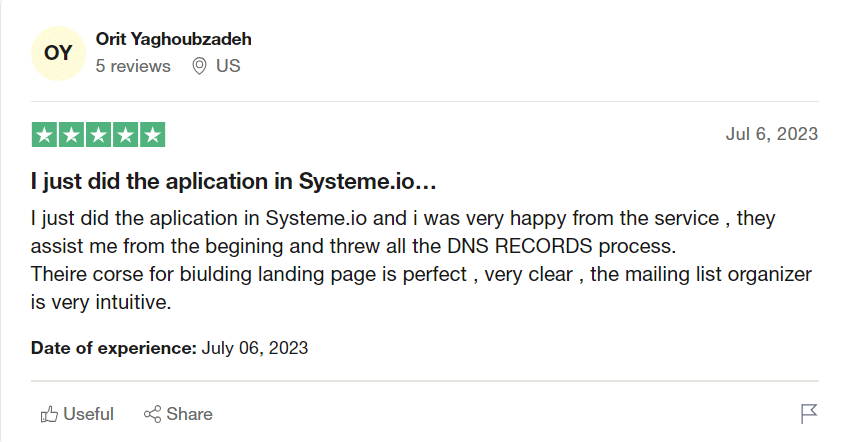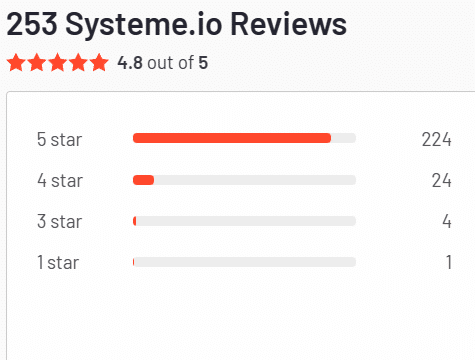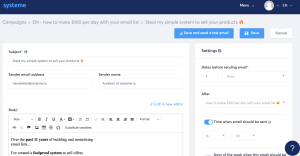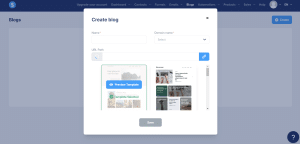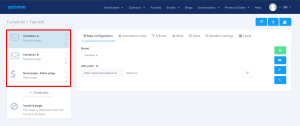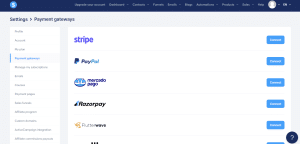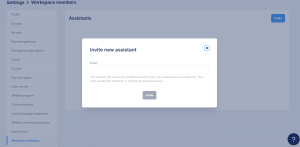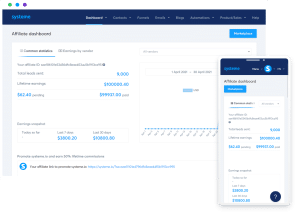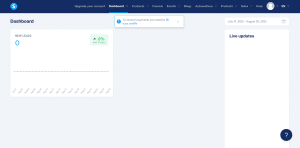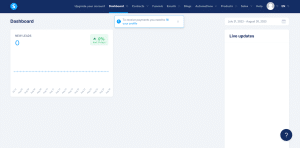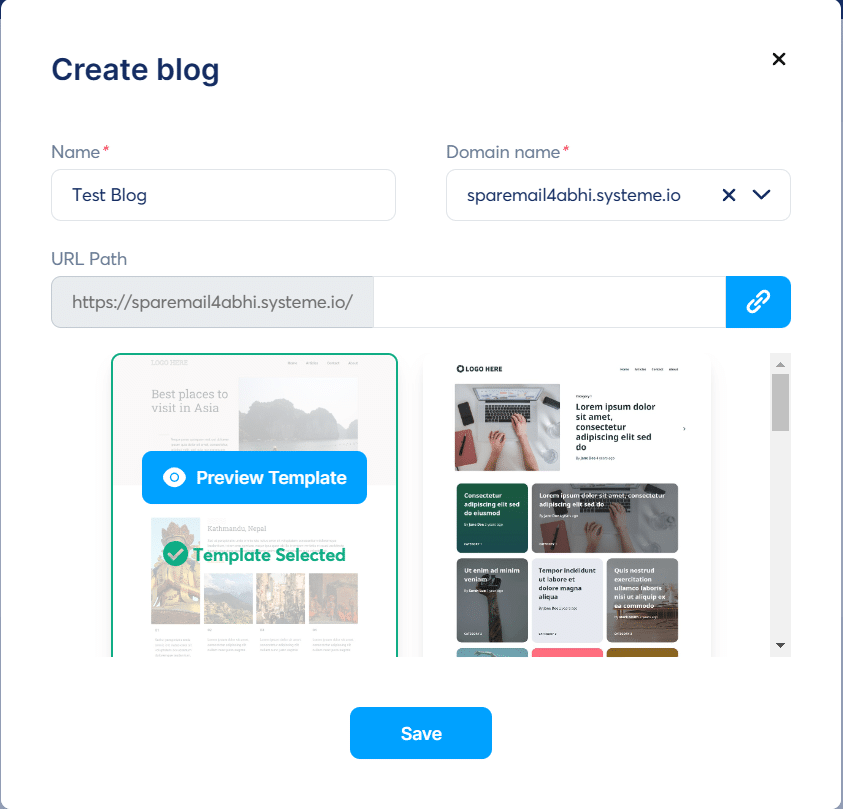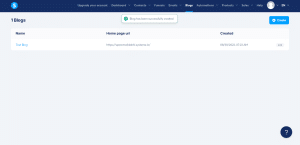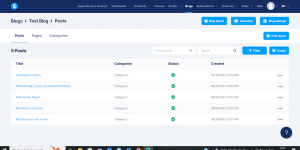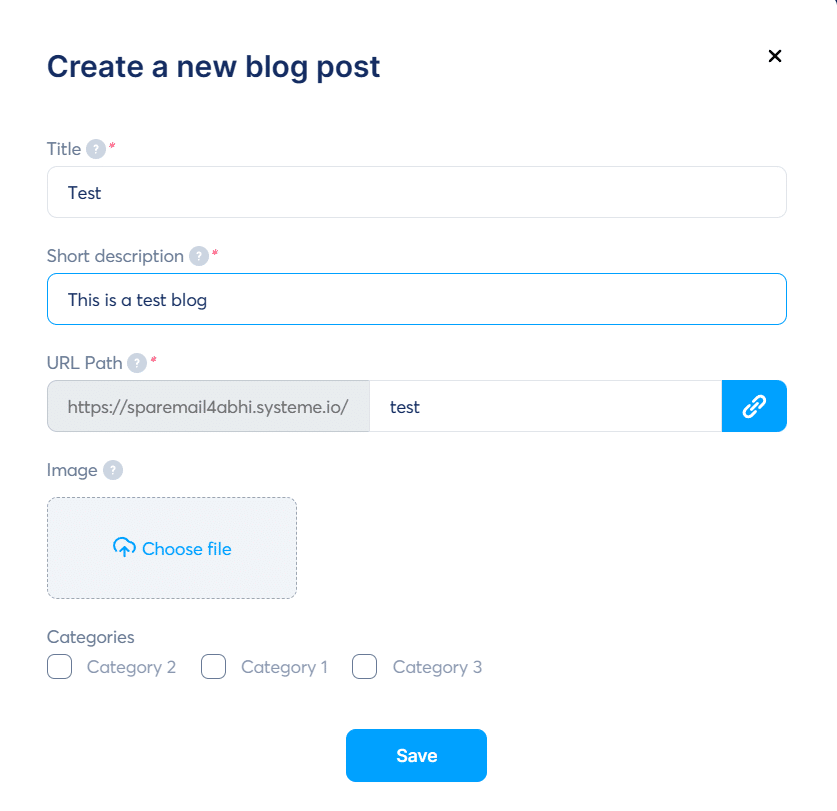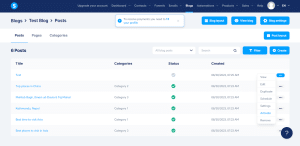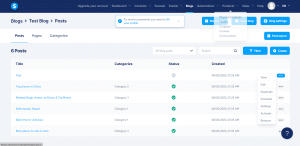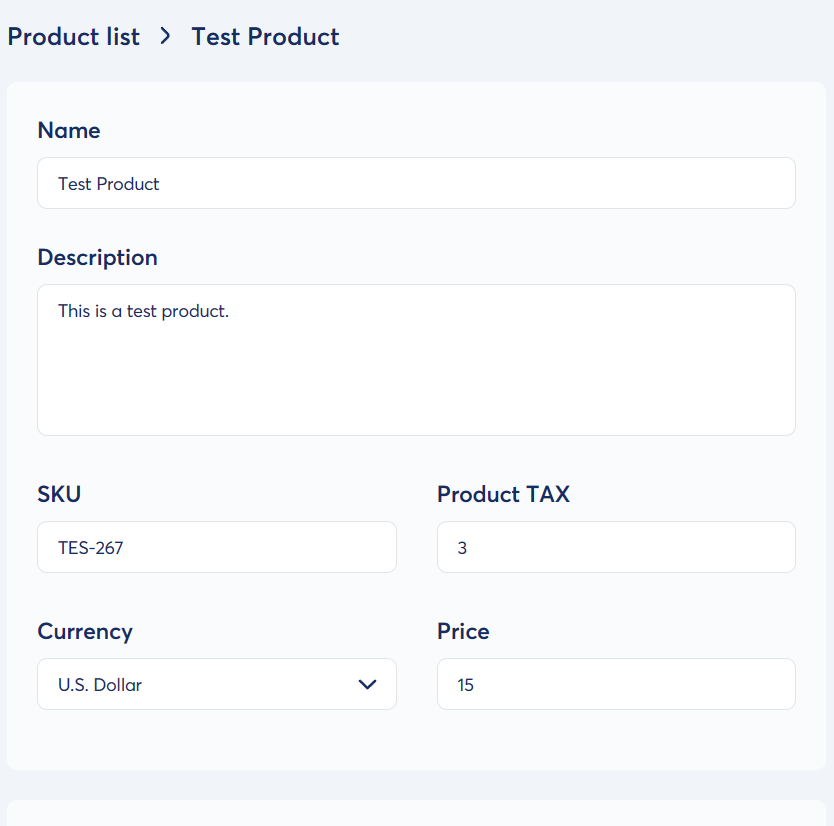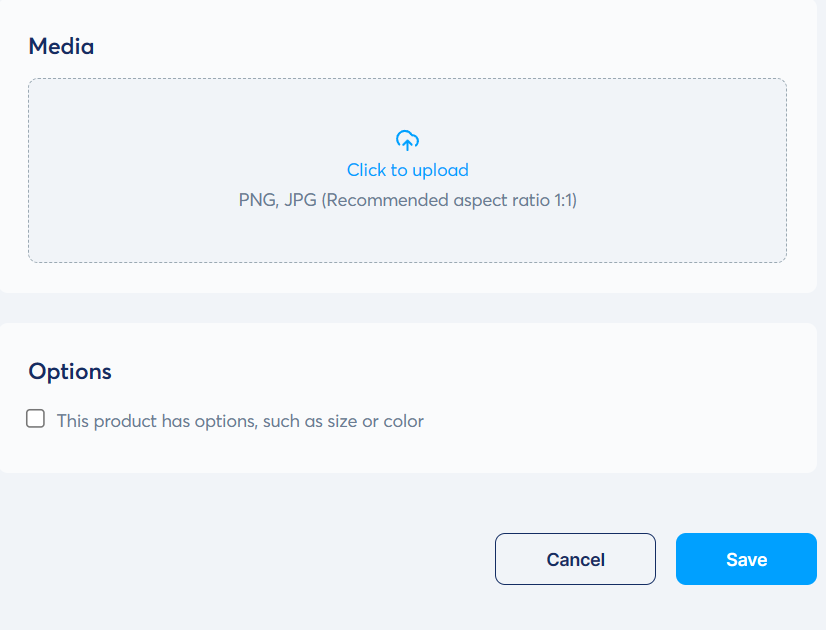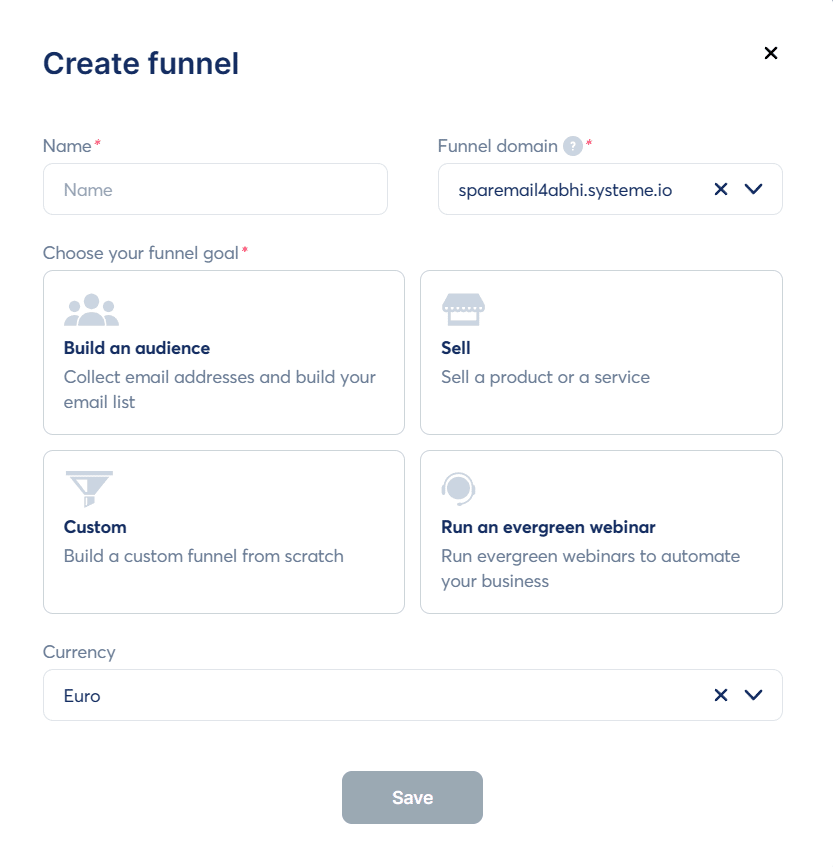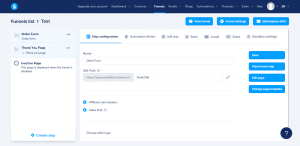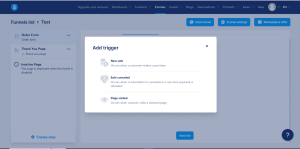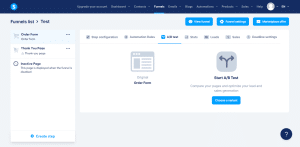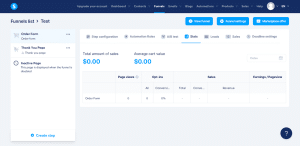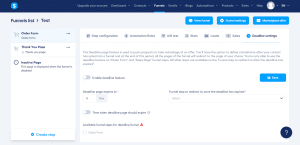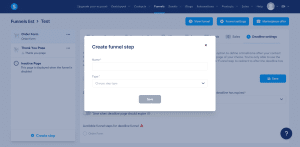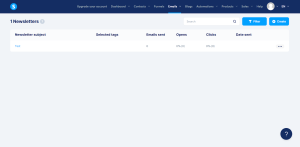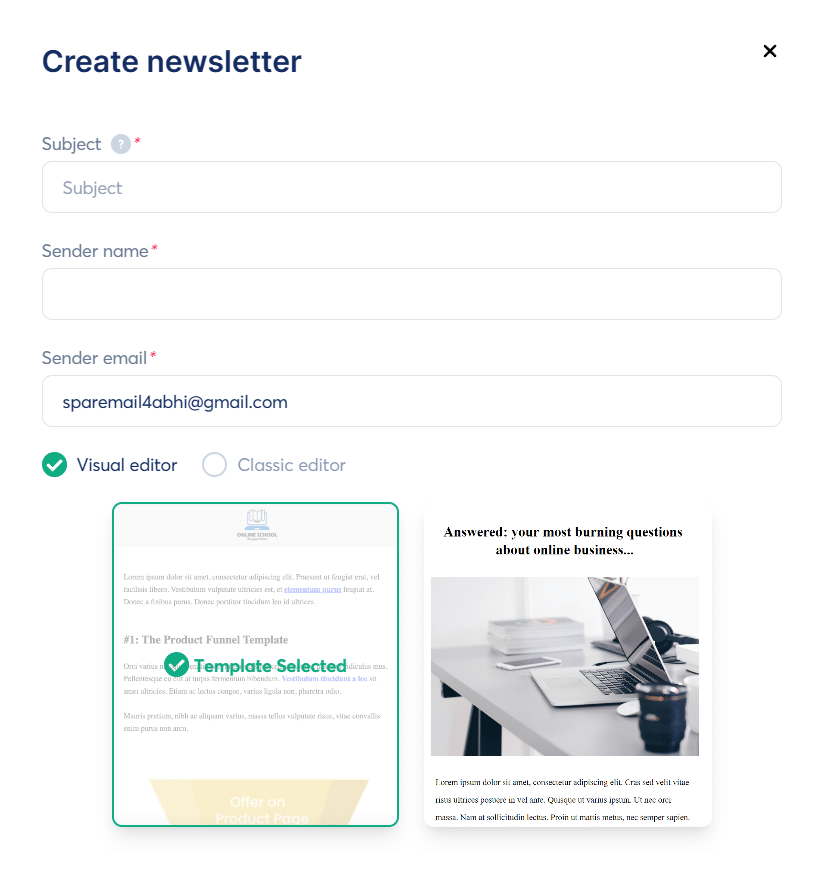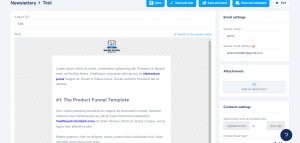Our comprehensive Systeme.io review delves into the depth of this all-in-one business tool. Building an online presence is indispensable for businesses today, and creating and managing sales funnels, email marketing efforts, building engaging blogs, and accepting online payments might sound like a lot of effort for a single business.
That’s where Systeme.io becomes a game changer. With its easy-to-use UI and drag-and-drop functionality, even a novice can manage multiple business functions with ease. However, like any other service out there, Systeme.io isn’t without its shortcomings, and our detailed guide will give you everything you need to ascertain whether it’ll do the job for you. Let’s get started.
What is Systeme.io?
It’s an all-in-one platform where you can create the product, create the funnel stages for its sale, manage your leads and customers with tools like email marketing, as well as get insight into your sales performance — all in one place.
What is Systeme.io Used for?
Systeme.io’s primary purpose is to help you set up and manage your online business from scratch. Here are some of its use cases:
- Email marketing
- Creating a sales funnel
- Building a new website/blog
- Automating certain business processes
- Affiliate program creation and management
- Creating digital content such as courses and webinars
Systeme.io Pros and Cons
Here’s a look into the advantages and disadvantages of using Systeme.io:
Pros
- The free plan is generous and great for small businesses
- Unlimited free storage on every plan
- You can easily create and run a blog by yourself
- Lets you create your own custom automation rules
- Provides A/B testing to see which page performs better
- You can create, manage, and sell multiple types of products
- Seamlessly integrates with popular payment apps such as PayPal and Stripe
Cons
- One-on-one coaching is only available on the top-tier plan
- The free plan only works for start-ups in the initial phase
Is Systeme.io Free? Exploring Systeme.io’s Pricing
One of Systeme.io’s biggest selling points is its affordability. Before we explore them more in-depth, here’s a quick glimpse into the Systeme io pricing structure:
Free
Systeme.io has a generous free forever plan that’s ideal for startups and small businesses. Under this, you can seamlessly integrate with various payment gateways and add unlimited assistant accounts.
Automation rules, A/B tests, and email campaigns are all restricted to only one, and you don’t get any migration support. That said, as long as you sell only a couple of products, this plan will suffice.
Startup
The Startup plan is the first paid plan you can consider when you want to scale your business. It comes with a few added perks like 3 custom domains, up to 10 A/B tests, and custom automation rules.
Beyond those, you also get to create email campaigns, and you’ll have the ability to create 10 funnels and 5 blogs at a time.
Webinar
The Webinar plan is ideal for midsize businesses with loyal customers. That’s because it lets you manage up to 10,000 email contacts at once.
Other benefits include the ability to create 100 automation rules and email campaigns and run 50 A/B tests. You also get to create and manage evergreen webinars — a feature that was missing on both the plans mentioned above.
Unlimited
As the name suggests, everything is unlimited on this plan, priced at $97/month or $828/year. We recommend this plan for established large-scale businesses and enterprises.
This is the only plan that offers free migration support and one-on-one coaching for new users as well.
If you don’t want your online store to experience too much downtime (the period of inactivity during which the transition happens), the Unlimited plan is a no-brainer.
Since Systeme.io has a free forever plan, you’ll have a lot more time to decide whether this platform is the right fit for your business.
But even after all the contemplation, if you decide it isn’t for you AFTER you pay for a subscription, you can avail of their 30-day money-back guarantee.
Upgrading your plan to a more expensive plan is quite simple. Just go to Settings > My > Upgrade Plan. However, downgrading a plan is a little trickier. You’ll have to contact their customer support team.
The team will provide you with an order form where you can choose your preferred plan. Then, you’ll have to wait for the team to cancel your previous subscription and activate the new one from their end.
Rest assured, though, that the customer support team is extremely friendly and responsive, and you’ll have any issue fixed in no time. This was evident in our experience and in our analysis of other customer experiences with the platform.
Payment Options
Systeme.io offers a fair number of payment options to pick from. You can go the traditional way and pay through your credit/debit card, or you can pay online through PayPal.
If you’re paying through a credit card, you can opt for auto-payments. This means that every month the subscription fee will be automatically deducted from your account.
Say you upgrade to a different plan, your payment for this month will be automatically carried over to a new subscription, and you’ll only have to pay the difference between the two plans.
However, this benefit isn’t available if you’re paying through PayPal. You’ll be charged the full price for your new plan, and you’ll also have to get in touch with support to cancel your previous plan.
Is Systeme.io Legit? A Look at Systeme Reviews
To know more about the actual performance of Systeme.io and whether it’s as good as it seems, we looked into some Systeme io reviews from real customers who are actual users of the service.
Popular review sites like Trustpilot and G2 have both given it a 4.8 rating based on 2,443 and 253 reviews, respectively. On TrustPilot, 92% of the reviewers have given Systeme.io a 5-star rating, and 5% have given it a 4-star rating.
Among many others, one of the most common talking points is Systeme.io’s beginner-friendliness. Not only does it provide migration support, but overall, the interface is easy to navigate.
Customers also appreciated the free forever plan, plus that paid plans are reasonably priced. Many of the users who shared their experience actually switched from a different platform.
Comparing their old platform with Systeme.io, they said it’s not only better but also more cost-effective. Plus, many Systeme.io reviews have also praised the customer support team.
As per these reviews, the customer support team is responsive, fast, and super helpful. The dedication they show in handling each customer query in record time is simply incredible.
However, Systeme.io’s approach to some 3-star reviews — where no solution to the shortcoming is made — is disappointing. Especially when you consider that there’s really not much negative to say about it — but when there is, we feel it could be dealt with better.
Moving on to G2, 224 out of 253 reviewers have given it a 5-star rating, and 24 others have given it a 4-star rating. Overall, users here really love Systeme.io’s comprehensiveness.
Everything you need to manage a business, from the end to the start, is available here, and the support has been said to be quick and efficient — helping users set up their business in no time.
An In-Depth Look at Systeme.io’s Features
Ready to learn more about what you can do with Systeme.io? Here’s an in-depth review of the best features it has to offer:
Email Marketing
Systeme.io offers several email management features. For starters, you can send bulk emails to unlimited users (even on the free plan). Simply create an email and select the contacts you want to send it to.
Of course, the main benefit of using emails for brand awareness is that you can communicate with a broad range of target audiences at the same time.
Plus, unlike other forms of communication, email marketing isn’t too imposing as long as you set up an opt-out option.
To save time, you can use one of Systeme.io’s predesigned templates and then send it to your entire contact list at once — which is great, whether for weekly emails, welcome emails, or an email campaign.
Once the email is ready, you can also schedule it for a time in the future instead of sending it immediately.
Blogging
If you want to create a blog, Systeme.io is the best option. Getting started is super simple, and you don’t need any coding knowledge. Simply go to “Blogs” from the header menu and create a new blog using one of the pre-designed templates.
Once the blog is created, you can manage the page layout, posts, and other elements of the page directly from your Systeme.io dashboard. You can also create separate categories for your blog.
For instance, if you’re running a lifestyle blog, you can divide your content into “Fashion”, “Fitness,” and “Recipes”. Creating a new post on Systeme.io is also super simple.
Along with the textual content, you can add extra widgets, such as a page footer, pricing plans, testimonials, and so on, with zero coding knowledge.
You’ll find these widgets on the left-side menu under the “Blocks” tab. All you have to do is drag and drop them to the page and adjust their position.
Setting Up An Online Store
Setting up an online store has never been this easy. Just like creating a blog, here, too, you don’t need any coding knowledge. The platform comes with a drag-and-drop Systeme.io website builder.
You just need to select widgets from the side that you want to include and arrange these elements with your cursor, which makes it no less than any dedicated top website builder.
You can create and sell any type of product you want. It could be a physical product in stock or a product you wish to dropship from a supplier.
You can also sell digital products such as Systeme.io courses and coupons, and depending on your plan, you can even add custom domains to your product. This will make it easier for your customers to recognize your brand.
Once your products are listed and the store is up and running, you can use Systeme.io to manage your orders. For this, you’ll have to click on the “Orders” option from the top header menu.
Click on “All Orders” for the drop-down menu that lets you choose to see fulfilled orders or unfulfilled ones. You can also filter these to see a specific order type and even those placed on a certain date.
Business Automation
Systeme.io is the best tool when it comes to business automation, as it lets you create your own rules. The feature is available under “Funnels”, and the format is pretty simple.
First, you create a “Trigger,” i.e., an event that initiates the process, and then add an “Action,” i.e., the action that follows when the event is triggered.
There are three types of events that can result in a trigger. You’ll see the options once you click the “Add Rule” button. You can trigger an event when a new sale occurs, a page is visited, or a sale is canceled.
After you add the trigger, you have a list of “Actions” to choose from. You can send an email, remove a tag, enroll them in a course, add a tag, and so on.
Let’s take an example to understand this. Suppose you want to automate communication with your customers. Let’s use a purchase as a trigger in this example.
As an action, you can make Systeme.io:
- Send an automated “Thank you for shopping with us” email
- And tag them as a customer of that specific product
This way, you know not to include them in marketing emails promoting the product they’ve already bought — which would result in them opting out of your emails.
As you can see, Systeme.io can be used to automate various repetitive processes that usually take up a lot of time, reducing the workload on your team while ensuring customers feel appreciated.
A/B Testing
Setting up an A/B test with Systeme.io is pretty simple. Once your product is ready, click on the “Funnels” option to create a new funnel. A/B tests are one of the steps in those funnels.
Then, you’ll choose a variant for the original page and click on “Start A/B Testing”. Let’s take an example. Suppose you’re creating a new course page but aren’t sure what template would work best.
In that case, you can create two pages for the same course. Let’s assume you stick to a classic, clean aesthetic on one page and experiment with colors and visual elements on the other page.
Then, you can run both these pages simultaneously and see which of the two is performing better. Run the test for a week or two, and then pick the best performer to be your final course page.
The benefit of A/B testing is that you’ll know exactly what your customers want. Take the guesswork out of the question — even for something as small as a CTA button — and put them to the test.
Although A/B testing is available even on the free plan, you can only create and launch one test, which is clearly not enough for a business. So, after the first month, it’s better to switch to a paid plan.
Payment Integration
If you’re running an online store, having a reliable payment partner is crucial. And thanks to Systeme.io, you can now manage your payments from the same platform.
All you have to do is integrate your Systeme.io account with a payment platform of your choice. Options include Razorpay, PayPal, Stripe, and Flutterwave.
The best part is that if you use PayPal and Stripe to accept online payments from your customers, you won’t have to pay any transaction fee; you can keep 100% of the revenue.
It’s hard to come by tools offering a free plan and still not charging for payments. It gets better with how easy integrating these payment portals with your Systeme.io account is.
For example, if you want to integrate your PayPal account, go to your Systeme.io account > Profile > Settings > Payment Gateways. You’ll then find all the payment options available for integration.
Click on the “Connect” button beside PayPal. Then, enter the API username, password, and signature, and click “Save”.
Team Management
The best thing about Systeme.io is it makes it super easy to manage a whole team and host your entire workspace online, thanks to the assistant accounts.
As the name suggests, you can use these accounts to invite your assistants onboard and add unlimited assistants right from the free plan itself.
You just have to click “Invite” and enter their email address. Within a few minutes, they’ll receive an email with the invitation link to the platform.
If they have a Systeme.io account, they’ll be automatically redirected to the login page. Otherwise, they’ll be led to the signup page, where they’ll have to register an account.
The assistants will have the same access level as the owner, i.e., you. If you want, you can also give them admin access, which will allow them to invite other assistants on board.
To be more precise, they’ll be able to create sales funnels, emails, newsletters, blogs, automation rules, manage workflows, and create physical products.
However, this unrestricted access isn’t what all businesses would want. Let’s say you want to add an employee to only create blogs but don’t want them dabbling in your sales funnels or emails.
This isn’t possible with Systeme.io, which can prove a risk to safeguarding sensitive business information. We hope to see some more user controls in the near future.
Affiliate Program
Anyone, regardless of your plan, can join the Systeme.io affiliate program. But did you know that you can also create your own affiliate program here?
Affiliate programs are a popular marketing technique used by companies to spread the word about their product. And the best part is, there’s no investment upfront.
Basically, you’ll hire someone to be an affiliate for you, they’ll spread the word and bring in new customers to your business, and you’ll pay them a percentage of what you’ll get off those customers.
You can use the same default configuration for your program that Systeme.io uses for its own program. Also, remember to create a sales funnel to reach out to more users.
Changing the settings of the program is easy. Just go to the Main Menu > Settings > Affiliate Program settings. Here, you can change the commission rate, payout date, and minimum payout amount..
Order Management
Systeme.io is always trying to help you make more money. That’s why it offers two amazing order management features — Order Bump and Upsell.
Under Order Management, you can automatically add a discount for an existing purchase at the checkout. This is a common tactic businesses use to increase their margins.
By adjusting the price with a discount at the end, the customer thinks it’s an extra rebate on their purchase. Customers are more attracted to high-price items with a discount than reasonably-priced items with no extra discount.
Upselling is also popular. It gives you one last chance to sell more to a customer. A common example of where this is seen is with ordering food online on apps like Uber Eats.
When you purchase a burger and fries, they’ll recommend you add a soda at checkout, for example. The aim is to make the customer invest more than they intended to.
By adding products usually bought together just before checkout, customers think twice and often end up adding something small to complete their meal.
ClickFunnels Vs Systeme.io: How Do They Compare?
If you’ve been looking up business management tools and sales funnel creators, then you’ve probably heard of ClickFunnels — a popular website and funnel builder tool.
If you’re wondering which one out of the two is a better fit for your business, here’s a quick comparison of both. Let’s find out:
| Business Tool | Starting Price | Free Version | Email Contacts | Sales Funnels | Blogs | Automation Rules | Affiliate Program |
| Systeme.io | $27/month | Free forever | Starting from 2,000 to unlimited | Available | Available | Available | Available |
| ClickFunnels | $127/month | 14-day free trial | 10K to 200k contacts | Available | Available | Available | Available |
As you can see, both platforms have similar features. You can create sales funnels, manage blogs and affiliate programs, and set automation rules with both of them, but when it comes to pricing, there’s a massive difference.
For starters, Systeme.io has a free forever plan, whereas you only get a 14-day trial with ClickFunnels, so it’s clear as day that it’s nowhere near Systeme.io when it comes to courting individuals and small businesses.
Even when it comes to the paid plans, ClickFunnels is $100 more expensive than Systeme.io’s cheapest plan. But besides pricing, the differences when it comes to features are barely noticeable.
If anything, Systeme.io has the upper hand. For example, on its cheapest paid plan, ClickFunnels only lets you manage up to 10,000 email contacts, whereas, with Systeme.io, you can manage unlimited contacts.
Is it Easy to Learn How to Use Systeme.io?
Getting started with Systeme.io is incredibly easy. If this is your first time using the tool, here’s a quick guide on how to get started. First, go to the official website and create a new account. You’ll be asked to verify your email, after which you’ll have to log in again.
Once you’re in, the first page that you’ll see is the dashboard. Right now, it’s blank, but once your store is in full swing, you’ll be able to see all the important updates here.
How to Create a Blog
If you want to create a new blog. Select the “Blog” option from the top header menu. Then click on “Create” near the top-right corner.
After that, a new window will open where you can enter your blog’s title and domain and choose a template. After the blog is created, you’ll see an entry on the dashboard.
Now, click on the blog title to access the pages and posts, as you can see below in the picture:
From the top options on the right side, you can then change the blog’s visual layout, access its settings, and get a preview through the “View Blog” button before you publish your first post.
To create a new post, again click on “Create” and fill out the post details such as title, description, URL, and image. You can also create separate categories from your blog here. Once you’re satisfied, click on “Save”.
The blog will now show up on the post list along with the sample posts. Click on its name to open and edit it. It’ll look something like this:
You’ll see widgets on the left side of the page, which you can use to decide what elements you want in your post. You can choose to have a content box, a heading, a social share button, or an FAQ section.
The options are fully custom, so choose what you want and simply drag and drop them into place. Once you’re happy with the post, click on “Save Changes.”
Then, return to the page where you have the list of posts. Click on the three dots next to your new post’s name and click “Activate” to publish the post.
Selling a Product
If you want to set up an online store, these are the steps you need to follow. To start with, head to the dashboard and click on the “Products” option from the top header menu.
Now select the type of product you want to sell. It could be a physical product, coupon, course, or anything else. For this guide, we’ve selected physical products.
Now, just like the blog page, you’ll find a button on the top-right corner of the screen that says “Create”. Click on that to add a new product. For this guide, we’ve already created a test product.
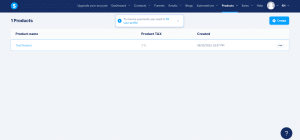
Scroll down a little more, and you’ll find the option to add an image. If this product has multiple options, such as different sizes or colors, check the “Options” box at the end of the page.
Creating a Funnel
Now that your product is ready, you need a funnel to roll in the customer. Here’s how you’re going to do it. First, select the “Funnels” option from the main menu and click “Create”.
In the next window, enter the funnel name and domain and choose your goal. In this case, our goal is to sell the product we created above. Then choose your currency of choice and hit “Save”.
Now, this is where all the magic begins. First, you need to create a page where the customers will be directed to your product. It could be a pricing page, shopping page, or discount page.
Whichever template you choose, you’ll have to add some extra information, as shown below.
Next, you can add some automation rules if you want. Add a trigger and then add an action that follows it.
Next, you can create an A/B test where you basically create another variation of the page you created above and then launch them both together to see which one performs better.
The next option is “Stats”, which is basically a glimpse into the template that’ll be used to give you insights into your sales and performance.
The next two options, i.e., “Leads” and “Sales”, will only work when you actually launch a product and the leads come rolling in, and the last option is “Deadline”.
You can use this feature to offer a limited-time offer on your products. Once the period is over, Systeme will automatically restore the original prices.
These are the steps available by default. But you are more than welcome to create any new step of your choice. Just click the “Create” button on the screen’s bottom-left corner.
Managing Emails
Whether you want to run an email campaign or send a weekly newsletter to your customers. Here are the steps you need to follow. To start with, click on “Emails” from the top header menu.
Now, choose what kind of email service you want. For this guide, we’ve selected newsletters. As with creating anything with Systeme.io, on the next page, you’ll find the “Create” option.
When you click this, a new window will open where you’ll be asked to select an email template and enter the sender name and email ID. Save it, and you’ll see a new email form on the list.
Click on the email’s name to open the editor. Type in your email and select the contacts you want to send it to from the menu on the right-hand side. And in just one click, each one of them will receive it.
These are the basic functions of Systeme.io, but there’s a lot more to learn. Thankfully, they have a detailed knowledge base where you’ll find tutorials on using this platform to its full potential.
Other Comparisons and Reviews of Business Tools
Although Systeme io is an all-in-one tool that removes the need for paying for multiple tools, if you’re still unsure, then we recommend checking out the below pages formulated by our experts to help people like you find the best tools for their business:
- The Best Cheap Website Hosting Services
- The Best CRM Software
- The Best Accounting Software
- The Best Website Builder
- The Best Ecommerce Website Builder
Why You Can Trust Our Analysis of Systeme.io
We dove deep into third-party review sites like G2 and TrustPilot to see what the users of Systeme.io have to say. We went through each one to understand what users love and hate about this platform.
We didn’t just consider new users, either; we scrolled until we could find the oldest users of Systeme.io to understand how the software performs in the long run and how far it’s come.
To understand Systeme.io better, we tested its free plan, too. After creating the account, we individually tested each feature, such as its Sales Funnels and Email Marketing tool.
Each feature was assessed on three parameters — ease of use, responsiveness, and functionality. Moreover, we’ve also tested many competitors, such as ClickFunnels and Hubspot.
Knowing how competitors work and what they have to offer made it easier for us to judge Systeme.io’s capabilities. Someone else’s experience with the platform might be different than ours, though.
But we tried our best to consider multiple dimensions and sources to put together a detailed & transparent review that the majority of the users will definitely find helpful.
Concluding Our Systeme io Review
Systeme.io is the perfect value-for-money business tool you’ve been looking for. It offers features like automated email marketing, a sales funnel builder, A/B testing, and unlimited blog posts and file storage on every plan (even the free one).
Having received tons of positive reviews, Systeme.io lets you build your online store and website from scratch and manage it through various business tools that are easy to use.
What’s more, it has a vast database of help articles that’ll guide you through every step of each business process it supports. Even if you’re stuck somewhere, they offer prompt customer support and an active community on Facebook.
